


Magnet basics
What really is a magnetic field?
Suppose you are holding a permanent magnet in your hand. All around the magnet will be its magnetic field. At any location close to the magnet or far away, anywhere around the magnet, the magnetic field could be measured or calculated. The measurement at a specific location will give you two things – the strength of the magnetic field at that location, and the direction of the magnetic field at that location. When a second magnet is brought closer to the first one, it looks as though they sense each other with either an attracting force or a repelling force. Actually, they aren’t sensing the other magnet, but they are responding to the magnetic field, created by the other magnet, that is present at their particular location. The direction determines if they will be attracted or repelled. The strength determines if the force is strong enough to actually move the magnet one way or another. So the magnetic field can create a force that can pull two magnets together or push them apart.
What is the magnetic field made of?
There are particles called gauge bosons that create the magnetic field that can push or
pull. The type of gauge bosons that are involved with magnetism are photons. These
are similar to photons of light, but we cannot see them.

What does the magnetic field look like?
We cannot see the magnetic field with our eyes, nor sense it with our fingers (unless our fingers get pinched between two magnets!). What does it look like and how does it vary around the magnet? Often the magnetic field is drawn with lines and arrows. These are called magnetic field lines. The arrows show the direction of the magnetic field at various locations, and the distance between the lines are an indication of how strong the field is at various locations. For example, this diagram is a simple way to show what the field is like around a permanent magnet.
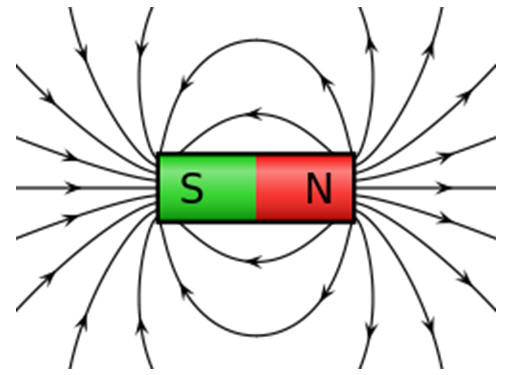
Sometimes people say that the field starts at the North Pole and goes around in the air
and ends at the South Pole. In reality, the field lines don’t start or stop, but are closed
loops like rubber bands, that can bend and stretch when affected by other magnetic
fields or materials. This other diagram is a better way to understand the field lines.

From this you can actually follow each line as it exits the magnet at the top (its North
Pole), travels around to the right or left, then re-enters the magnet at the bottom (its
South Pole). However, it doesn’t stop there! It continues to go through the magnet and
reconnects where it again exits the North Pole. These lines don’t start or stop and they
don’t cross one another. Where the lines are closer together, the field is stronger. The direction of the field at the red dot is shown with the red arrow. This is the direction the
compass would point if it were placed at that location near this magnet. You can also
see from this diagram that the field is strongest not at the center of these flat poles, but
at the edges of the poles! You can prove this by placing a small round steel ball onto
the middle of the surface of the pole of a disk magnet, and you will see that it will quickly
move to its edge where the field is stronger.
Some mistakenly think that the magnetic field exists only where the lines are drawn, but
not in between the lines. Actually, there are billions of lines and the field is all around
that magnet. This next diagram is a better indicator of where the field is located and
how its strength varies at different locations in the space around the magnet. The
colors of the background tell you the strength of the magnetic field within that
colored area. (blue is very weak, green to yellow to red is very strong) This doesn’t show the direction of the field,
though. The red dot and arrow were placed on this diagram from the previous one, so
you can see the direction of the field at the location of the red dot. The strength of the
field at that location happens to be about 0.035 Tesla (which is the same as 350
Gauss). This is determined from a chart that matches color shading with flux density.

Here are some more pairs of diagrams showing bar magnets, magnets with rounded ends, and two magnets in repulsion and attraction.
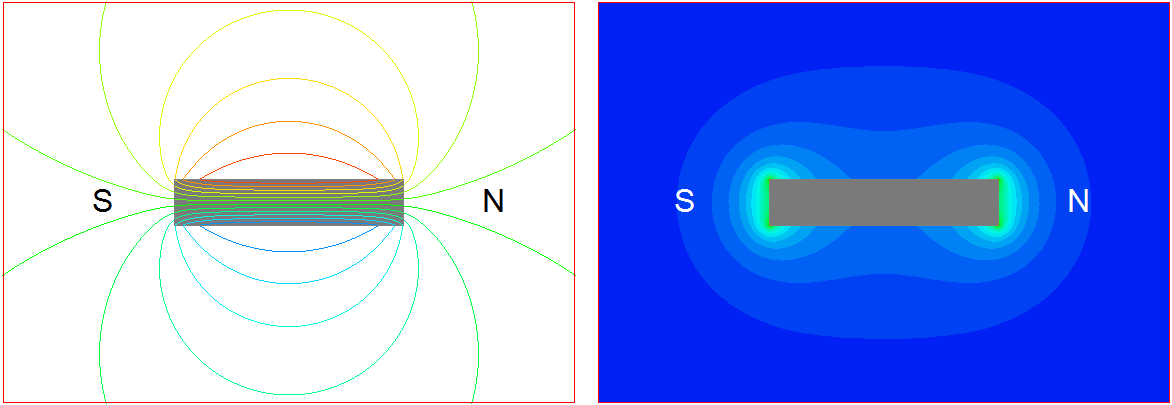
Bar magnet, flat poles (interesting “dog-bone” shape to the field strength diagram!)
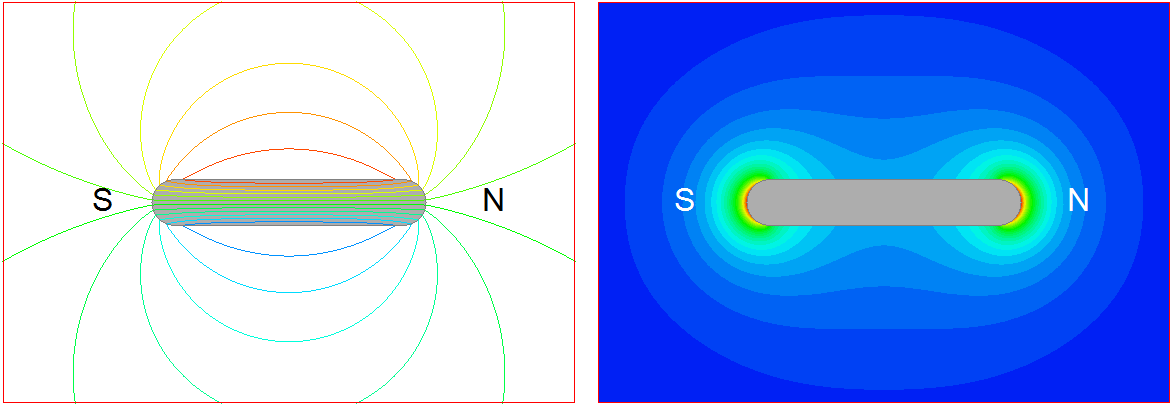
Bar magnet, rounded poles (field is strongest at the center of the rounded pole!)
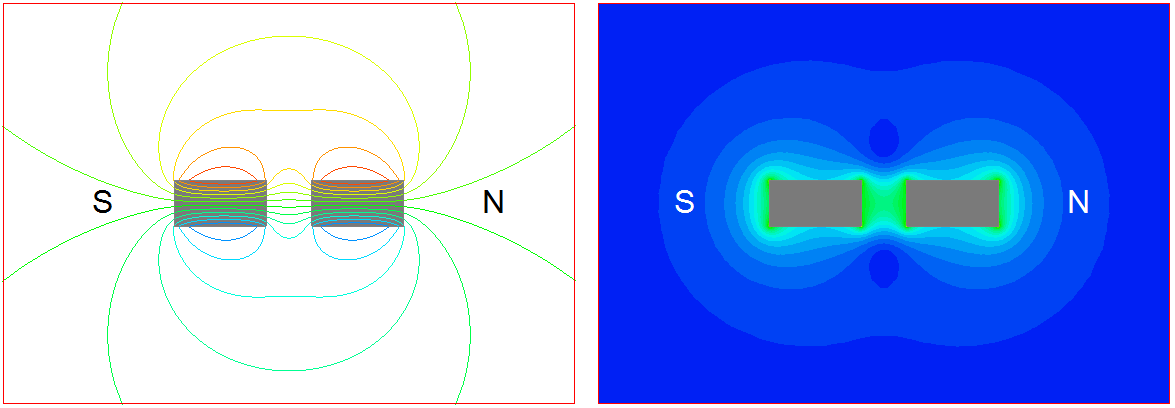
Two magnets attracting (strong field in the middle between the magnets!)
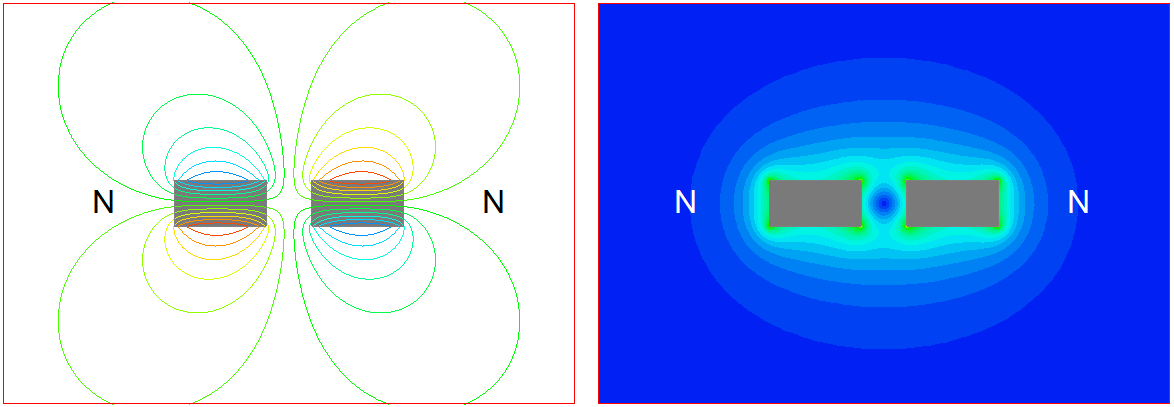
Two magnets repelling (almost no field in the middle between the magnets!)
With these diagrams I hope you have a better understanding of the magnetic field. This
is the field that makes motors spin, our compasses work, picks up cars, separates steel
from other trash, makes music come out of our ear buds, and thousands of other things
happen.
Amazing, isn’t it?
Click here to download a pdf of this article.